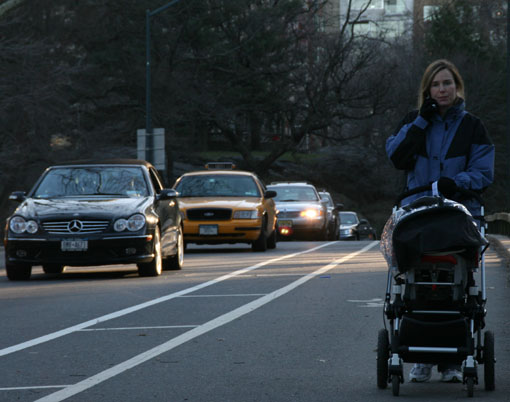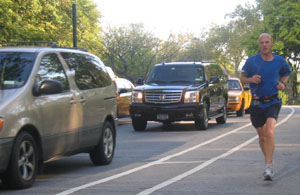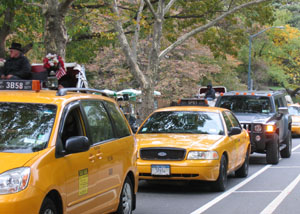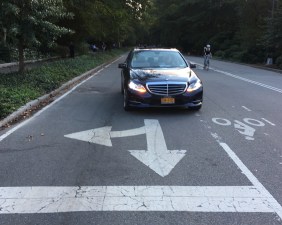Sacrificing Central Park to Appease the Traffic Gods
The Dept. of Transportation’s 2005 study showed there is no need to eliminate car-free hours during the holidays. So why did they do it this year?

Every November, year after year, the city sends two contradictory messages to motorists. On the one hand, it urges all those coming to the city during the holiday season to use mass transit. On the other, its Department of Transportation announces that to accommodate those who will be driving, the Central Park loop road will be open to traffic all day on weekdays from late November until early January, eliminating daytime car-free hours for the park’s recreational users. In effect, the city is saying, "We encourage you to use mass transit, but if you want to drive, we have this lovely park you can motor through that we hope will speed your way to Midtown!"
This double message aside, DOT’s own traffic data fails to demonstrate a need to throw open Central Park to traffic during the holiday season.
In 2004, the DOT studied the effects of entrance closings that had taken effect in November 2004 The report, published April 2005, can be found here: 2004 Holiday Traffic Plan: Central Park Drive Improvements (PDF file). As part of the study, the agency recorded traffic volumes at various entrances and exits on the loop drive and on several adjacent avenues both at the height of the 2004 holiday season (December 6-10 and 13-17) and after holiday hours had ended (January 10-14, 2005).
Unfortunately, DOT did not record traffic volumes during the five mid-day hours (10 am to 3 pm) that cars use the Park during the holiday period, but it did count cars during the morning and evening rush hours (7-10 am and 3-7 pm). One would expect that to justify opening Central Park to traffic all day, holiday traffic volumes would be substantially greater than during non-holiday periods. This is simply not the case. In fact, the data suggests there is less traffic.
 Central Park has two major exits for traffic traveling southbound. Traffic heading into Midtown is most likely to leave the park via the exit at 7th Avenue and Central Park South. The second-most popular exit for southbound cars leaving the park is the one at West 72nd Street.
Central Park has two major exits for traffic traveling southbound. Traffic heading into Midtown is most likely to leave the park via the exit at 7th Avenue and Central Park South. The second-most popular exit for southbound cars leaving the park is the one at West 72nd Street.
At the 7th Avenue exit during the rush-hour periods, fewer cars left the park during the holiday weeks than after the holidays: an average of 5,608 cars versus 6,732 cars a day, or 1,124 fewer cars. The West 72nd Street exit saw a small increase in traffic leaving the park during the holiday weeks: an average of 3,570 cars versus 2,960 cars, or 610 more cars a day leaving the park during the holiday period.
Adding it up, there were 514 fewer cars a day, on average, leaving the park at its two major southbound exits during the holiday weeks than afterwards.
Nor were the surrounding avenues unusually packed with cars. There was no significant uptick in traffic on the avenues adjacent to the Park during the holiday weeks compared with the post-holiday week. For example, the holiday versus post-holiday counts during the morning rush at Fifth Avenue between 62nd and 63rd were 4,296 versus 4,379; at Central Park West between 62nd and 63rd they were 1,002 versus 906; and at Columbus Avenue between 62nd and 63rd, they were 4,063 versus 3,954. That adds up to an average 82 additional cars a day during the holiday weeks on these avenues at a time when the city is supposed to be so gridlocked that the Central Park drive simply must be opened to traffic all day.
 What could be the reason for the DOT’s continued insistence that the world’s most famous urban refuge must be made available to any motorist who wants to speed through it in the middle of the day? I’m starting to believe that superstition is at work here, the same kind that prompted our ancestors to sacrifice virgins or sheep to appease the gods — only now, the DOT believes that if it doesn’t sacrifice a great urban park each year, the traffic gods will grow angry and something terrible will happen. But something terrible is already happening: For six weeks, recreational users of the Central Park Drives will have no escape from the danger, pollution and aggravation of traffic. The gods must surely be angry.
What could be the reason for the DOT’s continued insistence that the world’s most famous urban refuge must be made available to any motorist who wants to speed through it in the middle of the day? I’m starting to believe that superstition is at work here, the same kind that prompted our ancestors to sacrifice virgins or sheep to appease the gods — only now, the DOT believes that if it doesn’t sacrifice a great urban park each year, the traffic gods will grow angry and something terrible will happen. But something terrible is already happening: For six weeks, recreational users of the Central Park Drives will have no escape from the danger, pollution and aggravation of traffic. The gods must surely be angry.
Ken Coughlin is Chair of the Car-Free Central Park Campaign which has collected over 100,000 signatures in support of a car-free park.
